Text
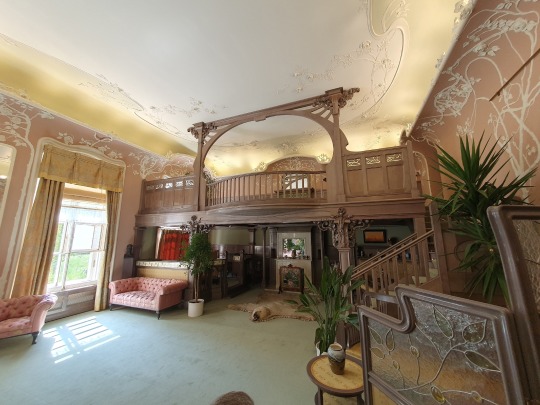
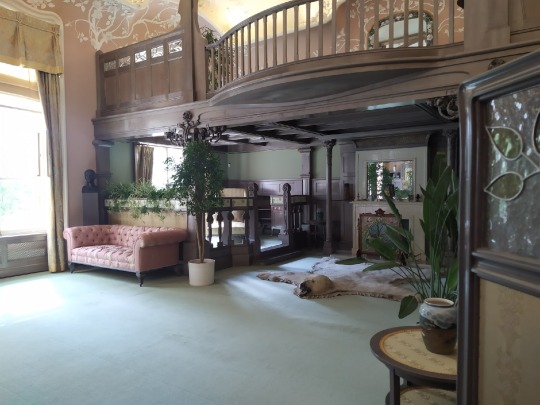


The Maple Living-Room of Her Majesty,
Alexander Palace, Tsarskoe Selo.
Circa. 2023.
_______________________________
This room needs no introduction honestly. It just IS.
_______________________________
Photograph Credit:
1. D. Schukin (VK).
2. E. Selivanova (VK).
3. N. Igonina (VK).
4. N. Volodina (VK).
_______________________________
Source: VK
_______________________________
Please enjoy these photographs! Also, if you’d like to share and/or re-post these photographs elsewhere PLEASE credit D. Schukin, E. Selivanova, N. Igonina and N. Volodina, accordingly. Thank-you!
#alexander palace#imperial russia#reconstruction#restoration#gmz tsarskoe selo#tsarskoe selo#romanov#empress alexandra feodorovna#art nouveau#style modern#jugendstil
23 notes
·
View notes
Text

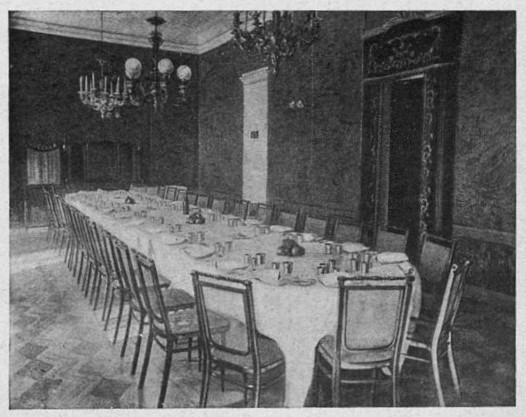
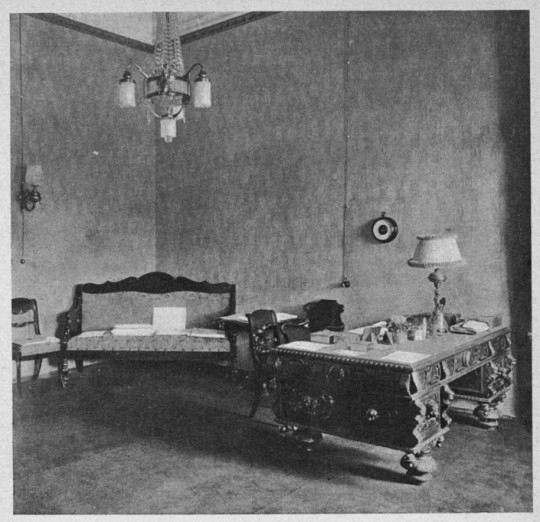
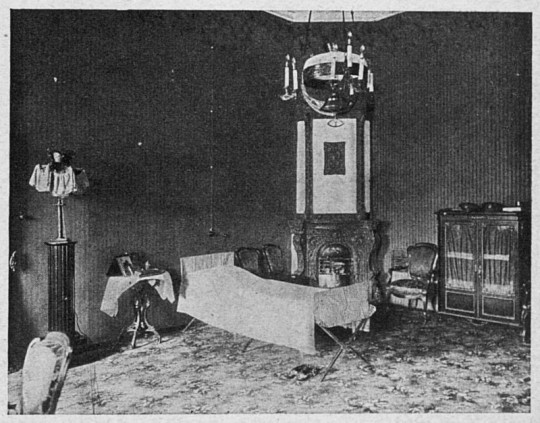
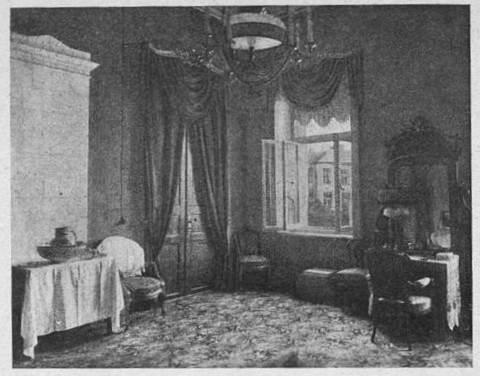

Photographic views of the apartments of the Governor's Mansion in Mogilev - Stavka, or GHQ (General Headquarters) during the Great War - when His Majesty, Tsar Nicholas II was in residence.
Spartan at first, the Emperor made use of what he was given. The first two photographs show the state rooms where social functions were held. The Reception Hall was not only used for functions but also for showing moving pictures - as evidenced by the screen infront of the corner firestove. The second photograph depicts the State Dining-Room where His Majesty would entertain visiting officials, and the like.
What furniture that you see in the photographs such as his working-study (third, first row) and his more private apartment - the bed-room had furniture from around the mansion brought in. The camp-bed naturally travelled with His Majesty where ever he went.
The second photograph, second row shows a corner of the bed-room where the Tsar's dressing-table can be seen, and then the last photograph shows the Tsesarevich Alexei's own camp-bed next to his father's. Alexei's camp-bed specifically came from Tsarskoe Selo and would travel back home with him when he would return.
These photographic views, which are illustration plates come from the publication entitled:
"Его Императорское Величество государь император Николай Александрович в действующей армии."
"His Imperial Majesty Sovereign Emperor Nikolai Alexandrovich in the army."
Edited by Dmitry N. Dubensky, and published in 1916, this, like many other war-time publications featured stories and articles about the war effort, and photographs and illustrations of the Tsar and Tsesarevich, as well as, other members of the Imperial Family - used to boost morale of the men who were fighting on the front lines. It is an interesting glimpse into the world of Russia during this period - the Great War.
______________________________
Photographs:
1. Reception Hall at Mogilev, Stavka.
2. State Dining-Room at Mogilev, Stavka.
3. Working-Study of His Majesty.
4. Bed-Room of His Majesty.
5. Bed-Room of His Majesty.
6. Bed-Room of His Majesty.
Source:
http://elib.shpl.ru/ru/nodes/13680-iyul-1915-fevral-1916-g-1916
______________________________
Please enjoy the information, as well as, the photographs!
Also, if you’d like to share and/or re-post these photographs
elsewhere PLEASE credit The State Public Historical Library or Государственная публичная историческая библиотека, accordingly. Thank-you!
#tsar nicholas ii#tsesarevich alexei nikolaevich#alexei nikolaevich#romanov dynasty#great war#russian empire#wartime publications#obscure russian books#state public historical library#military life#mogilev#stavka#general headquarters#imperial russia#romanov
36 notes
·
View notes
Photo

A recent photograph of the Maple Living-Room of the Alexander Palace at Tsarskoe Selo, Russia. You’ll notice many more plants and furniture have been added, including a runner of grey-green carpet for the staircase with treads, seat cushions for the arm-chairs, and other things. GMZ Tsarskoe Selo has also added carpeting up in the entresol (balcony/mezzanine) of the room, and some furniture as well.
Little by little, life has been breathed into this timeless room. Even if some may decry the wood tone, and that some textiles haven’t been recreated, etc - think of the fact that the museum is on a budget, and largely had to make use of its own funding for this project - the rehabilitation and restoration of the Alexander Palace. It’s still not finished - work still continues and will do so until next year or more!
________________________________
Photograph Credit: “Влюблённые в Петербург” (Lovers in Petersburg) via VK.
Date: June, 2023.
________________________________
Please enjoy the article and information, as well as, the photographs! Also, if you’d like to share and/or re-post these photographs elsewhere PLEASE credit GMZ Tsarskoe Selo, and Lovers in Petersburg, accordingly. Thank-you!
#alexander palace#imperial russia#tsarskoe selo#saint petersburg#romanov#art nouveau#maple living room#jugendstil#reconstruction#recreation#restoration#gmz tsarskoe selo
38 notes
·
View notes
Photo



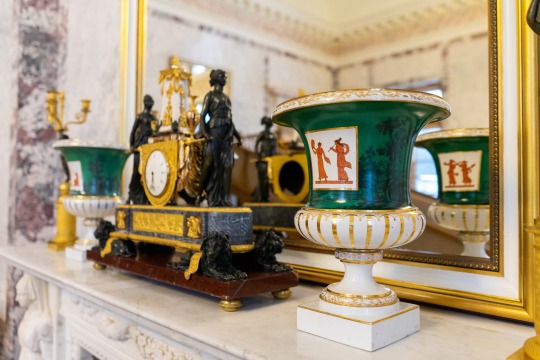
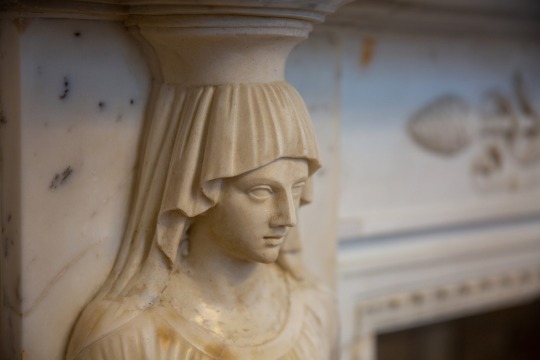
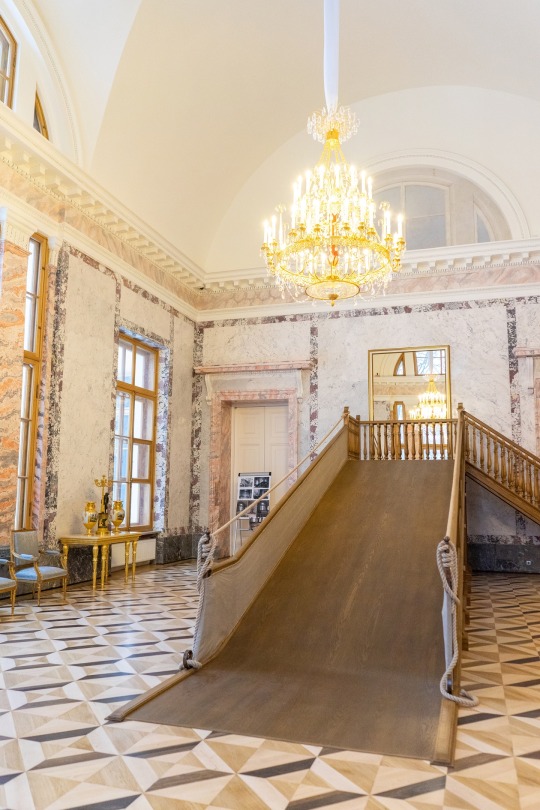

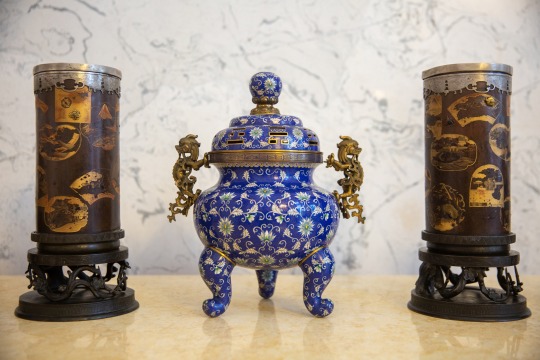
Yesterday, GMZ Tsarskoe Selo (the Tsarskoe Selo State Museum Preserve) published a generous photographic spread on the now beautifully-restored Mountain Hall which visitors can now walk through as part of the permanent exhibition of recreated and restored interiors in the Alexander Palace!
This part of the project to rehabilitate the Alexander Palace into part museum, and part multi-resource centre has been much discussed. This room, with its wooden slide or "mountain" as slides are known in Russia has been meticulously and painstakingly restored and partially recreated using old photographs, drawings, inventories from the museum period, and other archival materials. Objects which once stood in this room on the fireplace mantle, and on console tables are now back in their rightful place. The fire-screen is the original, just reupholstered. The furniture also comes from GMZ Tsarskoe Selo's own collection. The lunettes of faux sky have also been brought back to life.
Below, I've translated (using Yandex Translate, which is better than Google by far) the article which GMZ Tsarskoe Selo published yesterday on the opening of the Mountain Hall. I translate from the original Russian as I know not everyone in the group speaks the language or can read/write it so this is for ease of reading and also for those members who are not as tech-savvy as well.
So please enjoy the article, and the wonderful photographs which also include some that I added for a comparison of how the room was once, and how it comes to us today.
Also, let's not forget the monumental work that has been done thus far. There is still work being done and it is just wonderful, and a miracle that it is being done at all. It's important to remember these workers and the many companies/firms which have had a hand in this project.
________________________________________________________________
RESTORATION OF THE HALL WITH A SLIDE COMPLETED.
"The restoration of another interior of the Alexander Palace has been completed in the Tsarskoye Selo Museum-Reserve. The hall with a slide is part of the front suite; its decoration was made at the end of the 18th century according to the project of the architect Giacomo Quarenghi. For the first time in 80 years, visitors will see the hall as it was before the start of World War II. This is the fourteenth interior opened to the public during the large-scale restoration of the Alexander Palace. From February 2, the Hall with a slide will be included in the excursion route.
The personal apartments of Emperor Nicholas II and his wife Alexandra Feodorovna in the Alexander Palace became available to visitors in August 2021. The restoration of the palace began in 2012 and is carried out mainly at the expense of funds allocated by the Ministry of Culture of the Russian Federation, as well as at the expense of the museum's own funds. The decoration of the Hall with a slide was recreated with the support of the Transsoyuz Charitable Foundation.
– For us, the opening of the Hall with a slide is a continuation of the grandiose restoration epic of the Alexander Palace. I am glad that patrons took part in recreating the decoration of this unusual interior. Let me remind you that the Agate Rooms were restored at the expense of the Transsoyuz Foundation, the lapis lazuli portals of the Lyon Hall of the Catherine Palace were recreated,” says Olga Taratynova, director of the Tsarskoye Selo Museum-Reserve.
The hall with a slide got its name due to its main compositional element: in 1833, at the behest of Nicholas I and Empress Alexandra Feodorovna, a roller coaster brought from the Anichkov Palace was installed here, which was presented to the imperial children by their grandmother, Dowager Empress Maria Feodorovna. The children of the imperial couple rolled down the hill on rugs. The hill, having undergone repairs in 1843, was in the hall for almost a hundred years, until 1941.
The interior restoration project was developed by the specialists of the Architectural Bureau "Studio 44"; the restoration of the interior and the reconstruction of the slide according to their own project was carried out in 2019-2021 by the specialists of PSB ZhilStroy.
The interior, like other halls of the front suite, has retained some elements of the original decoration. In the process of work, the artificial marble of the walls of light gray and lilac shades, typeset parquet and a fireplace were restored; Based on historical photographs, a picturesque frieze was recreated imitating artificial marble, as well as oak door and window fillings.
While working in the lunettes (architectural spaces in the shape of a crescent), a genuine oil painting on canvas imitating windows was discovered under late painting, it was cleared and the losses made up. During the restoration of the ceiling, it became clear that the rosette in its center, which was considered to be stucco, is a metal, genuine one, which appeared in the hall, most likely during the renovation of the interior in the 1840s; it was dismantled, put in order and installed in its place.
The project of manufacturing a chandelier according to a historical model was developed by specialists from the Tsarskoye Selo Amber Workshop; complex and painstaking work on creating a copy of a chandelier for 40 candles was performed in the Yuzhakova Studio workshop.
The exposition includes: furniture (from the museum's collection); decorations made of bronze and porcelain, including paired porcelain vases on the mantelpiece and a mantel screen, which historically come from this interior; bronze clock and candelabra with figures of Orpheus and Eurydice.
Initially, in archival documents of 1796–1809, this interior was called the First Front Room. According to the project of Giacomo Quarenghi, the walls were finished with multi-colored "false" marble and decorated with pilasters with capitals. The room was heated by a "piece tiled" stove with copper and iron doors. The floor was oak parquet. The ceiling was painted "in stucco work" by the painters Giacomo and Ferrari.
In 1809, the New (Alexander) Palace was transferred to the Tsarskoye Selo Palace Administration. In the inventory for this interior, the replacement of structural elements and the correction of painting and "false" marble are indicated.
The furniture set of the First Front Room consisted of four gilded console tables with marble boards, eight gilded armchairs and 12 chairs. On the wall hung a large mirror in a gilded and painted frame. Two crystal girandoles were used for illumination.
In 1833, at the behest of Emperor Nicholas I and Empress Alexandra Feodorovna, a roller coaster was installed in this interior. The ceremonial hall “where the Rolling Hill”, located between the Portrait Hall and the Library, eventually began to be called the “Gorkovy”, and then the Hall with a slide. In 1836, a bronze chandelier with 40 pipes was sent to light the Hall with a slide.
In the 1840s, repairs were made in the Hall with a slide, connected with the installation of "warm floors" - heating according to the so-called Amosov system. During this period, the ceilings in the Hall with a slide were whitewashed, a marble fireplace was made, the parquet was replaced, and the rolling hill was remade by the carpenter Bolgagen. In the report of the painter Vdovichev, submitted to the Tsarskoye Selo Palace Administration in April 1843, it is indicated that he was “... in the New Palace in the Front Rooms, painting in friezes under fake marble painting.”
Vsevolod Yakovlev, director of the Association of Palaces and Parks of Detskoye Selo, wrote about the use of the roller coaster: his children rolled off her on the rugs. In the last reign, during ceremonial breakfasts and dinners, an orchestra was located near the hill; under it, bicycles of Nicholas II and his children were usually kept. Today, toy cars are placed here ... and two carriages with bicycles, presented by someone to the son of Nicholas II."
________________________________________________________________
Photograph Credit: Tsarskoe Selo State Museum Preserve (GMZ Tsarskoe Selo).
________________________________________________________________
Please enjoy the article and information, as well as, the photographs! Also, if you'd like to share and/or re-post these photographs elsewhere PLEASE credit GMZ Tsarskoe Selo, accordingly. Thank-you!
#alexander palace#gmz tsarskoe selo#mountain hall#russian empire style#neoclassical style#giacomo quarenghi#18th century#restoration#romanov#tsar nicholas i#tsar nicholas ii#transsoyuz charitable foundation
113 notes
·
View notes
Photo
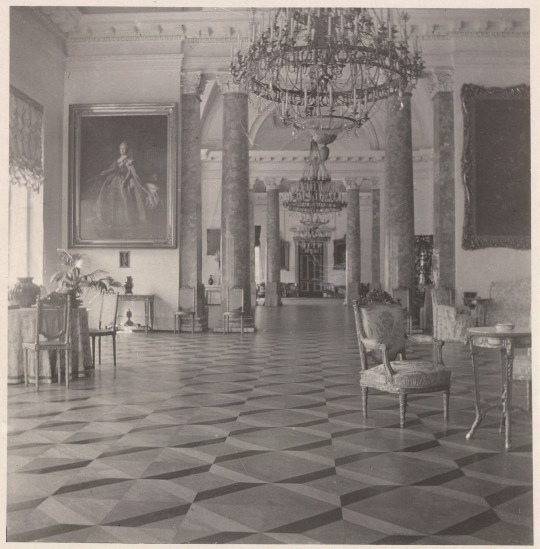
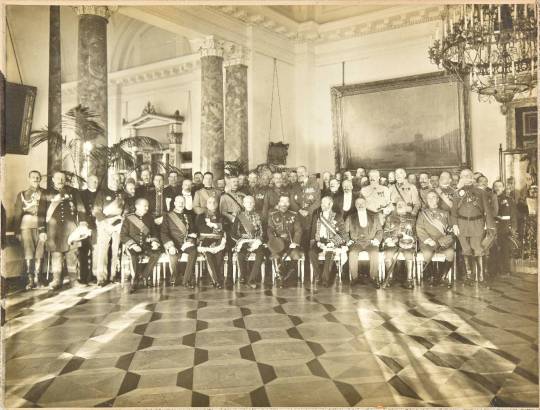

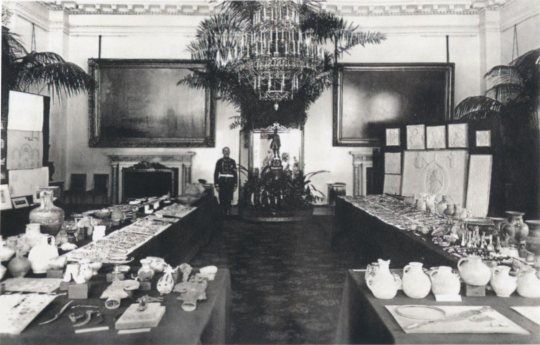
Various photographs of the Parade Enfilade of Quarenghi - Alexander Palace, Tsarskoe Selo
Today, I wanted to talk more about Quarenghi's Parade Enfilade, which has been discussed at length in several posts now. Recently I made two posts on the decoration of plants and flowers in the Alexander Palace, of which these figured prominently in the State Apartments. The trouble is, there are not many photographs which show the greenery which decorated Quarenghi's Parade Enfilade.
From research, I've found some discussion on the plant decorations of the Parade Enfilade, namely that they were only for display during exhibits, gala dinners and luncheons. However, from the photographs that can be found, it is obvious that Their Majesties kept live plants in these three rooms. They varied through-out the reign of Tsar Nicholas II, and as mentioned in a previous post detailing, in depth about the greenery and floral decorations of the Alexander Palace, via the book "Tsarskoe Selo: Familiar and unfamiliar." Written by former, senior archivist Galina Semenova:
"In 1913, the last delivery took place, which was stopped due to the First World War. The plants from the state halls were removed in the spring of 1917, from the private apartments –shortly after the removal of the royal family to Tobolsk. The museum exposition opened in the palace without plants. In preparation for the opening of the museum in 1918, all the jardinieres were removed from the front halls, partially left for display in private rooms."
Below, I've compiled four photographs which show some of the plant decorations which flourished in Quarenghi's Parade Enfilade. Along with these photographs is some information pertaining to each photograph.
Please enjoy!
________________________________________________________________
In one photograph, which comes to us from the Beinecke Rare Book and Manuscript Library, via one of the six albums rescued by Anna Vyrubova, one of the Empress's ladies-in-waiting, a view can be seen from the Portrait Hall through to the Marble Drawing-Room. Some of the furniture pieces have dust covers on them for protection, and there are some plant decorations still in place (namely a palm tree which was one of four, kept in galvanized steel basins, and a fretwork of ivy or another type of greenery which was usually kept at the left corner of the columned arcade leading into the Portrait Hall. This fretwork of greenery can also be seen in the photograph of the Parade Enfilade, Circa. 1909 (which has been posted in two previous posts)), which suggests the Imperial Family was either leaving on holiday or visiting another country, or just returning home.
However, there are also some other photographs which were made, one in early February of 1917, and the other two during an exhibition in the early part April, 1910.
The photograph from 1917 is of interest as it shows a view of the Semi-Circular Hall, mainly taken for a group portrait of the Tsar with delegates, officials and Mission members of the Allied Mission to Russia which was headed by Alfred Milner, 1st Viscount Milner. During Milner's visit, a state dinner was given on 4 February, 1917. As there is no indication of a visit by Lord Milner to Russia prior to 1917, the photograph could only have been taken in early 1917 at the state dinner mentioned. Lord Milner can be seen, sitting to the left of His Majesty in the group portrait. In the back-ground, to the left can be seen two, low-lying palm trees. As mentioned above, in Mme. Semenova's book, the order for plants and flowers had been halted because of the War. To the immediate right can be seen a sculpture of Tsar Peter I, in-front of a wood and glass folding-screen, and at its base a jardinière for other plant decoration. This photograph was taken by the Court Photographer, Hahn (C.E. de Hahn & Co).
The aforementioned photographs made in April of 1910, were taken during the Exhibition of the Imperial Archaeological Commission. This exhibition was opened in 1910, and shows two, L-shaped tables laid out, along with display easels, etc. for exhibiting the finds of the Commission. One notices immediately the tall palm tree groupings which can also be seen in the photograph taken of the Parade Enfilade (1909), also by the Court Photographer, Hahn.
________________________________________________________________
Photographs:
1. The Parade Enfilade of Quarenghi, Alexander Palace. Circa. 1909-1910.
2. Allied Mission to Russia, Group Portrait in the Semi-Circular Hall, Alexander Palace. Circa. 4 February, 1917.
3. Photograph of the Exhibition of the Imperial Archaeological Commission in the Semi-Circular Hall, Alexander Palace. Circa. 4 April, 1910.
4. Photograph of the Exhibition of the Imperial Archaeological Commission in the Semi-Circular Hall, Alexander Palace. Circa. 4 April, 1910.
Sources:
"Tsarskoe Selo: Familiar and unfamiliar." - Galina Semenova. Published Circa. 2018, revised in 2010. (Царское Село. Знакомое и незнакомое)
Yale University, Beinecke Rare Book and Manuscript Library: Album No. 4 (1909-1910)
New College Library, University of Oxford (Milner Collection)
Institute of the History of Material Culture RAS (Институт истории материальной культуры РАН)
C.E. de Hahn & Co. (Court Photographer to Tsar Nicholas II)
Link of courtesy:
http://loveread.ec/view_global.php?id=94414
https://collections.library.yale.edu/catalog/4
https://www.new.ox.ac.uk/.../3NCN7%20(2013)%20Morgan%20...
https://www.archeo.ru/
________________________________________________________________
As always, please enjoy! If you'd like to re-post the photographs PLEASE credit Galina Semenova, Yale University, the Institute of the History of Material Culture RAS, C.E. de Hahn, Court Photographer, and Oxford University, appropriately. Thank-you!
#alexander palace#tsarskoe selo#yale university#beinecke collection#oxford university#alfred milner#1910#1917#russian archival material#giacomo quarenghi#photographs#palm trees#tsar nicholas ii#romanov#imperial russia
11 notes
·
View notes
Photo

The Parade Enfilade of Quarenghi - Alexander Palace, Tsarskoe Selo (1909-1910)
In the Collection of Yale University, as many know, is the Beinecke Rare Book and Manuscript Library. Part of this collection comes in the form of several photograph albums and a good deal of written letters, etc. These albums which were brought over by Anna Vyrubova, one of the Empress’s ladies-in-waiting give a rare glimpse into the private life of the Imperial Family. These photographs were not meant for public eyes, however they’ve been digitised regardless of this.
In Album No. 4, on page 40 of this album is a photograph which was taken in the Parade Enfilade which was designed by Giacomo Quarenghi, and of the Palace, is part of the original, surviving interior decoration from the mid-1790′s (1796). The view shows the Enfilade looking from the Portrait Hall, through to the Marble Drawing-Room (formerly a billiard-room during the reign of Tsar Nicholas I).
It’s interesting to note that some furniture pieces have protective dust covers on them. Also of note are some of the live plants which populated this series of state halls during when the Imperial Family was in residence at Tsarskoe Selo. It is likely that the photograph was made during the “shuttering” of the Palace for when the Imperial Family went on holiday or were visiting other countries, or when they were just returning.
Usually, large carpets and rugs were laid out and tall palm trees (of 13 feet in height) stood between the four sets of columns and pilasters which split the Enfilade up effectively into three halls. These palm trees, including a fretwork of greenery (which can just be seen between the column and pilaster (to the right, by the covered grouping of furniture in the back-ground), and a date palm (of no more than 10 feet) which sat on a pedestal, normally decorated the Parade Enfilade. In the Portrait Hall, at the four corners of the room were kept tropical greenery in galvanized, steel basins - one of which can be seen at the left corner, mentioned above.
Also of note is the furniture of the Parade Enfilade which was a mélange of antique and more newer pieces. In the Portrait Hall, were kept a variety of furniture pieces ranging from a suite from a set of furniture designed by Georges Jacob which was kept in the Arabesque Hall of the Catherine Palace, to a newer set of similarly-designed furniture of white and gilding (by the firm of N. Svirsky) which was used interchangeably with the Jacob Suite when the Imperial Family were in residence. Along with these pieces were gilded, wooden-framed chairs from the Chinese Theatre, several of which can be seen through-out the hall, including a crowd of them surrounding a table with a long table cloth. At fore-ground is a gilded, bucranium head’s table with a marble top and hooved feet with one of the Jacob chairs. This table was one of several made by the Svirsky Firm for the Empress’s Corner Drawing-Room. Along with this table, were two lapidary tables of variegated blue stone and gilding, also from the Catherine Palace, executed in the Louis XVI style during the reign of Empress Catherine II by the Peterhof Lapidary Works.
In the adjoining Semi-Circular or Oval Hall (as it was also called), were a set of 48, Russian Empire style beechwood chairs which were enameled and decorated with gilded ornamentation typical of the Empire style. In 1909, the design of these chairs, by the Court Architect, Silvio Danini was executed by the firm of F.F. Meltser & Co., a firm synonmous with the last Tsar of Russia’s reign.
At the end of the Parade Enfilade (before one moved into the more private house chapel (formerly the Raspberry Living-Room of Empress Alexandra Feodorovna (Charlotte of Prussia)), the furniture suite of the Marble Drawing-Room consisted of pieces which were manufactured between 1830-1840, respectively. This suite of furniture, sculpted in mahogany with gilded ornamentation, was originally kept in the Concert Hall (which had been demolished in early 1902). Among this suite of furniture were also gilded, wooden-framed chairs which also had been in the Concert Hall, previously. These chairs can be seen in the photograph of the Parade Enfilade (Circa. 1909), and one of the autochromes of the Marble Drawing-Room (Circa. September 1917).
Despite the carnage and savagery of the Second World War, and prior to, the selling of the objects and works of art by the Soviet government during the period when the Palace was a museum (1918-1941), quite a few pieces of the furniture suites which decorated the Parade Enfilade have survived.
Currently, GMZ Tsarskoe Selo is in the process of a large-scale reconstruction and restoration project which is seeing to the restoration of elements of Quarenghi’s beautiful state apartments. It is planned for the project to be fully complete no later than 2024.
________________________________________________________________
Photographs:
1. Parade Enfilade of the Alexander Palace.
Sources:
Beinecke Rare Book and Manuscript Library, Album No. 4
Link of courtesy:
https://collections.library.yale.edu/catalog/4
#alexander palace#tsarskoe selo#gmz tsarskoe#1909#1910#giacomo quarenghi#anna vyrubova#silvio danini#meltser#furniture#plants#georges jacob#russian archival material#yale university#beinecke collection#photographs#chairs#table
7 notes
·
View notes
Photo

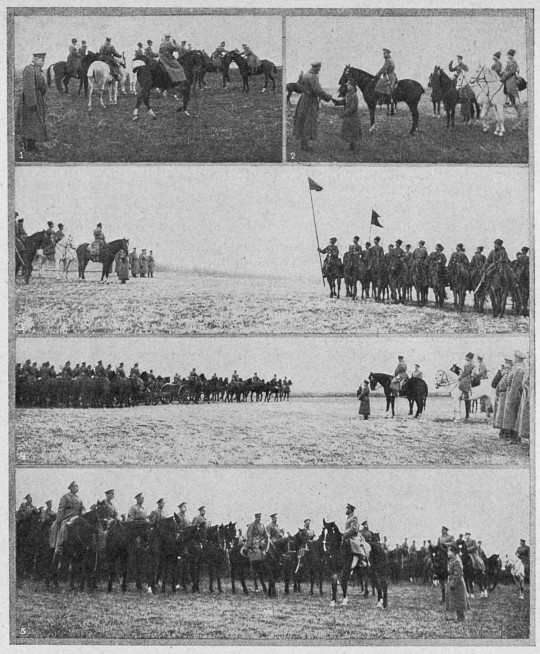


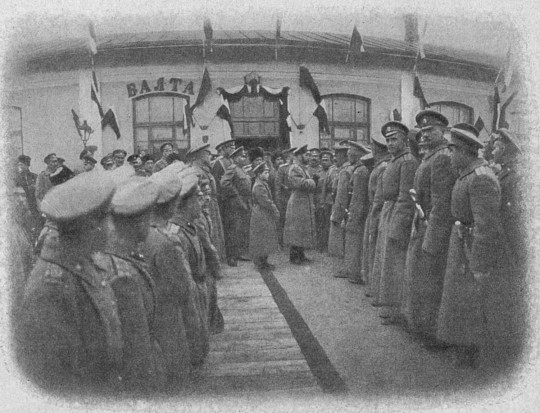


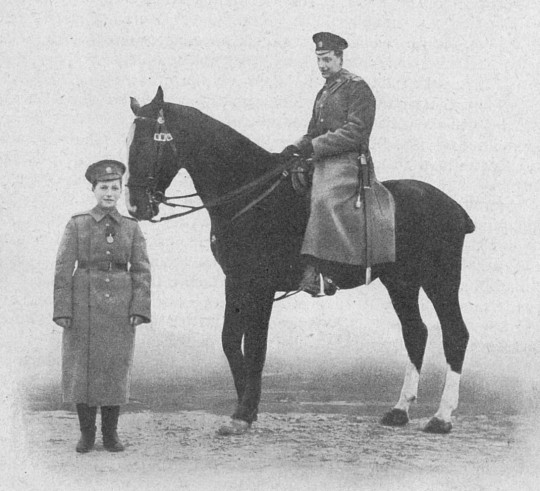
Photographs of the Imperial Family during the First World War - At Mogilev and Environs (1916) - Part V (Final in the series)
These photographs (illustration plates) come from the publication entitled: “His Imperial Majesty Sovereign Emperor Nikolai Alexandrovich in the army,” which was published by Dmitry N. Dubensky, part of a series (four were published) depicting the Tsar’s and his family’s (mostly the Tsar and Tsesarevich) activities during the Great War (1914-1918). Most of the photographs were taken at (and re-used in postcard form, etc.) Mogilev and the surrounding environs of Stavka (General Headquarters, GHQ).
________________________________________________________________
Source:
“His Imperial Majesty Sovereign Emperor Nikolai Alexandrovich in the army.” - Dmitry N. Dubensky. Published, Circa. 1916. (Его Императорское Величество государь император Николай Александрович в действующей армии)
Link of courtesy:
http://elib.shpl.ru/ru/nodes/13680-iyul-1915-fevral-1916-g-1916
#mogilev#stavka#1916#russian archival material#obscure books#great war#first world war#tsar nicholas ii#tsesarevich alexei#romanov#imperial russia
18 notes
·
View notes
Photo


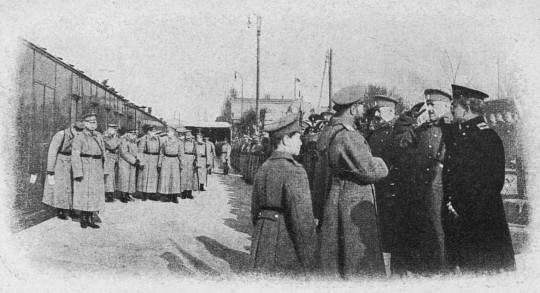

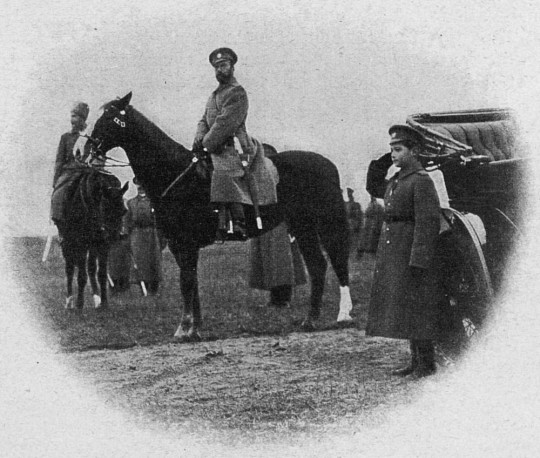




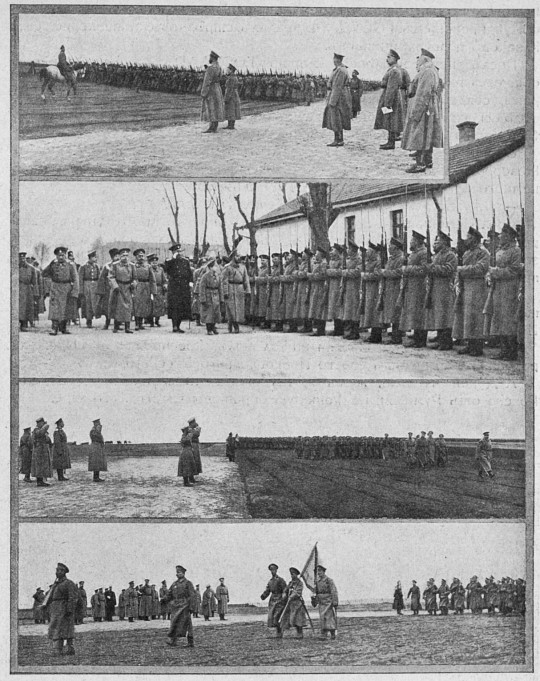
Photographs of the Imperial Family during the First World War - At Mogilev and Environs (1916) - Part IV
These photographs (illustration plates) come from the publication entitled: “His Imperial Majesty Sovereign Emperor Nikolai Alexandrovich in the army,” which was published by Dmitry N. Dubensky, part of a series (four were published) depicting the Tsar’s and his family’s (mostly the Tsar and Tsesarevich) activities during the Great War (1914-1918). Most of the photographs were taken at (and re-used in postcard form, etc.) Mogilev and the surrounding environs of Stavka (General Headquarters, GHQ).
________________________________________________________________
Source:
“His Imperial Majesty Sovereign Emperor Nikolai Alexandrovich in the army.” - Dmitry N. Dubensky. Published, Circa. 1916. (Его Императорское Величество государь император Николай Александрович в действующей армии)
Link of courtesy:
http://elib.shpl.ru/ru/nodes/13680-iyul-1915-fevral-1916-g-1916
#mogilev#stavka#1916#russian archival material#obscure books#great war#first world war#tsar nicholas ii#tsesarevich alexei#romanov#imperial russia
19 notes
·
View notes
Photo

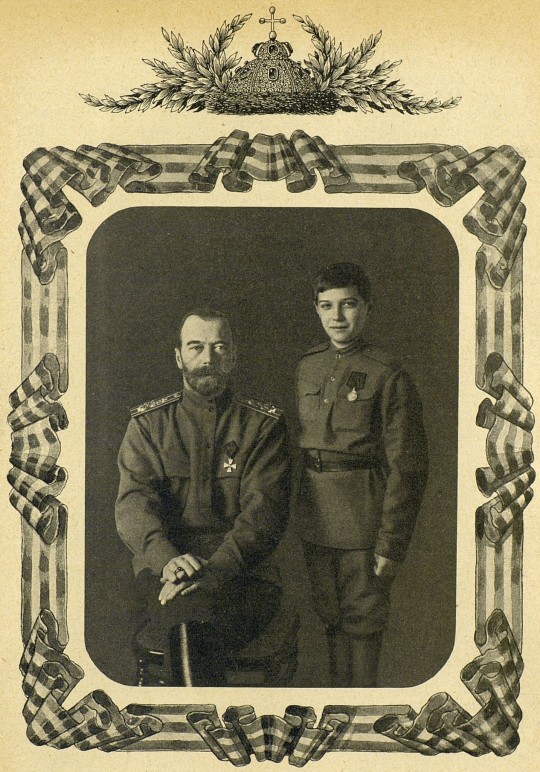
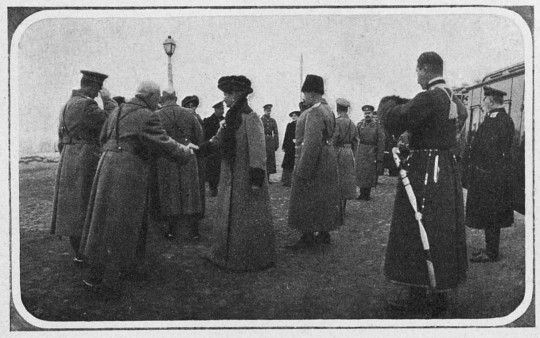







Photographs of the Imperial Family during the First World War - At Mogilev and Environs (1916) - Part III
These photographs (illustration plates) come from the publication entitled: “His Imperial Majesty Sovereign Emperor Nikolai Alexandrovich in the army,” which was published by Dmitry N. Dubensky, part of a series (four were published) depicting the Tsar’s and his family’s (mostly the Tsar and Tsesarevich) activities during the Great War (1914-1918). Most of the photographs were taken at (and re-used in postcard form, etc.) Mogilev and the surrounding environs of Stavka (General Headquarters, GHQ).
________________________________________________________________
Source:
“His Imperial Majesty Sovereign Emperor Nikolai Alexandrovich in the army.” - Dmitry N. Dubensky. Published, Circa. 1916. (Его Императорское Величество государь император Николай Александрович в действующей армии)
Link of courtesy:
http://elib.shpl.ru/ru/nodes/13680-iyul-1915-fevral-1916-g-1916
#mogilev#stavka#1916#russian archival material#obscure books#great war#first world war#tsar nicholas ii#tsesarevich alexei#romanov#imperial russia
6 notes
·
View notes
Photo
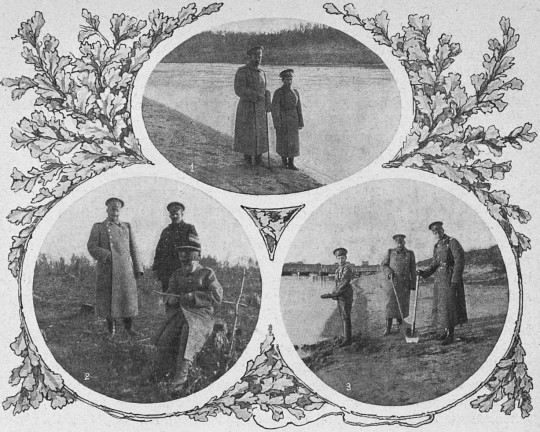
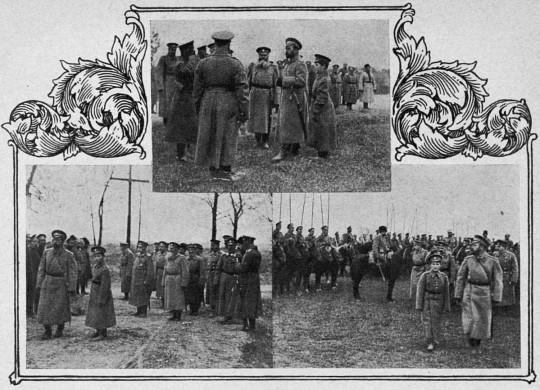
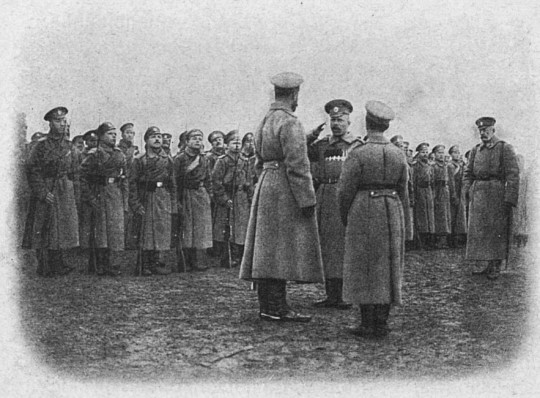


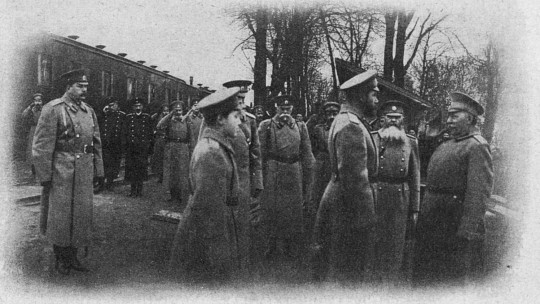
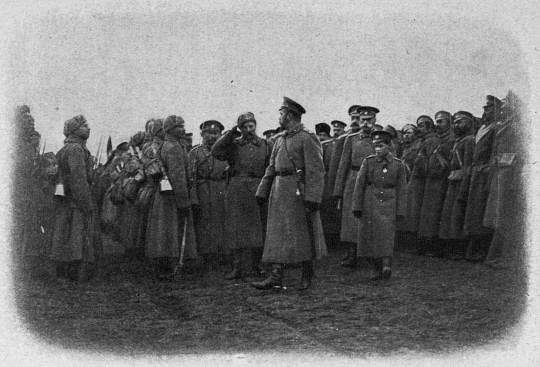



Photographs of the Imperial Family during the First World War - At Mogilev and Environs (1916) - Part II
These photographs (illustration plates) come from the publication entitled: “His Imperial Majesty Sovereign Emperor Nikolai Alexandrovich in the army,” which was published by Dmitry N. Dubensky, part of a series (four were published) depicting the Tsar’s and his family’s (mostly the Tsar and Tsesarevich) activities during the Great War (1914-1918). Most of the photographs were taken at (and re-used in postcard form, etc.) Mogilev and the surrounding environs of Stavka (General Headquarters, GHQ).
________________________________________________________________
Source:
“His Imperial Majesty Sovereign Emperor Nikolai Alexandrovich in the army.” - Dmitry N. Dubensky. Published, Circa. 1916. (Его Императорское Величество государь император Николай Александрович в действующей армии)
Link of courtesy:
http://elib.shpl.ru/ru/nodes/13680-iyul-1915-fevral-1916-g-1916
#mogilev#stavka#1916#russian archival material#obscure books#great war#first world war#tsar nicholas ii#tsesarevich alexei#romanov#imperial russia
5 notes
·
View notes
Photo
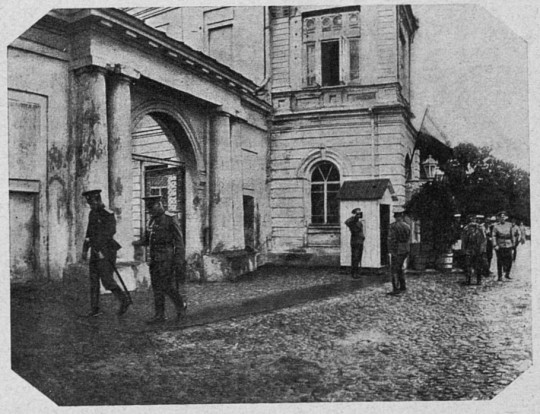
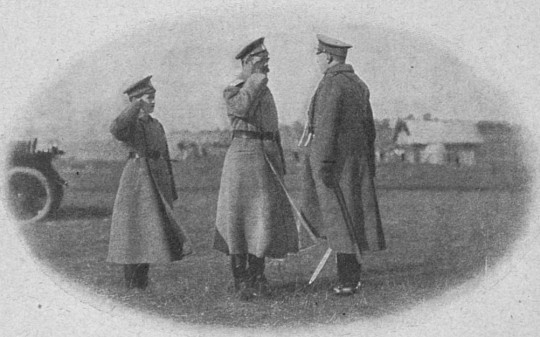
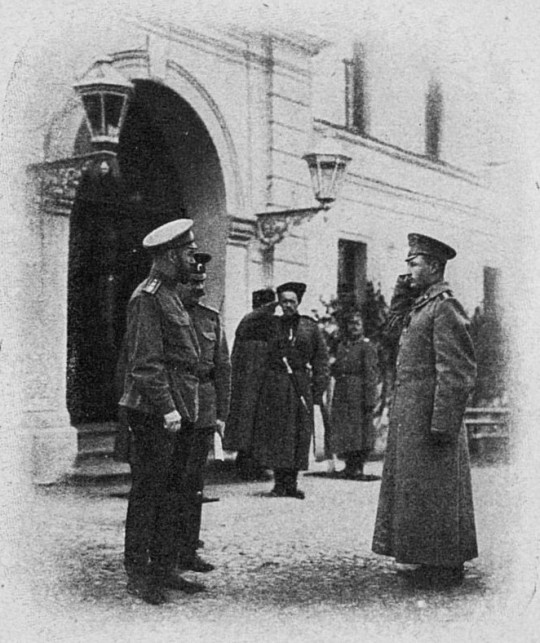




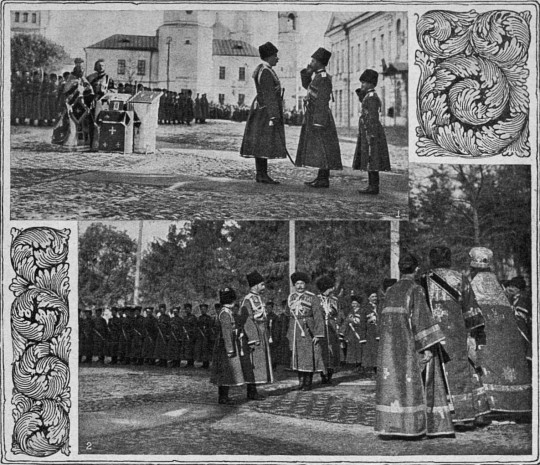

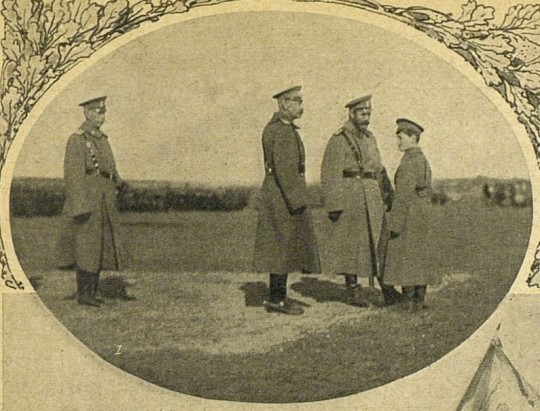
Photographs of the Imperial Family during the First World War - At Mogilev and Environs (1916) - Part I
These photographs (illustration plates) come from the publication entitled: “His Imperial Majesty Sovereign Emperor Nikolai Alexandrovich in the army,” which was published by Dmitry N. Dubensky, part of a series (four were published) depicting the Tsar’s and his family’s (mostly the Tsar and Tsesarevich) activities during the Great War (1914-1918). Most of the photographs were taken at (and re-used in postcard form, etc.) Mogilev and the surrounding environs of Stavka (General Headquarters, GHQ).
________________________________________________________________
Source:
“His Imperial Majesty Sovereign Emperor Nikolai Alexandrovich in the army.” - Dmitry N. Dubensky. Published, Circa. 1916. (Его Императорское Величество государь император Николай Александрович в действующей армии)
Link of courtesy:
http://elib.shpl.ru/ru/nodes/13680-iyul-1915-fevral-1916-g-1916
#mogilev#stavka#1916#russian archival material#obscure books#great war#first world war#tsar nicholas ii#tsesarevich alexei#romanov#imperial russia
1 note
·
View note
Photo
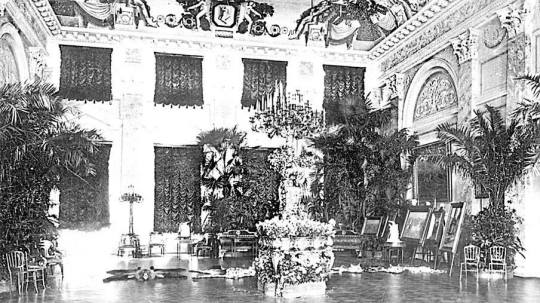








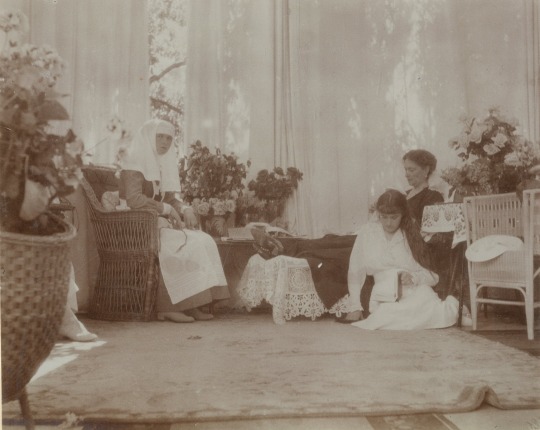
That photograph of the Parade Enfilade actually made me want to delve more so into the plant and flower decorations of the Alexander Palace, which there is a great deal of description. Via the publication, entitled "Tsarskoe Selo: Familiar and unfamiliar." Written by Galina Semenova, a former senior archivist (she passed away in 2014), and published in 2018, the book was republished with new information in 2010.
Mme. Semenova's work is an absolute treasure-trove of information on just about anything you could think of from the beginnings of Tsarskoe Selo to how it exists now. There is so much information, ranging from many, different topics.
As mentioned above, there is one chapter in particular which goes into great depth on the Alexander Palace's floral and plant decoration, which during the reign of Tsar Nicholas II played a large part of the lives of the Imperial Family. It's a bit on the long side, but I think it wouldn't be given justice if I only shared excerpts. Also, if you wish to read the original Russian (as I am translating this with Yandex), I shall link the book from a website where it can be read freely.
Please enjoy!
________________________________________________________________
"... And the shadow of patching flutters on the enamel
wall." Decorative plants in the decoration of the palace in the late XIX early XX centuries
"One of the photos of the Concert Hall shows how fan-leaved latanias looked in the interiors of the Alexander Palace. There were many huge palm trees, decorated in the form of compositions with evergreens. Two tall latanias are visible at the back wall. Their size can be determined by the window openings and the cornice, which passed at a height of 10 m and corresponded to the height of the currently existing front enfilade. The highest latania, therefore, had a height of 8-9 m, the one next to it – about 6 m.
It can be assumed that, in connection with the reconstruction in 1902, the latanias, along with the mahogany furniture set and the skin of one of the tigers, were moved from the Concert Hall in the Billiard Hall. In the Billiard room in front of the mirror portal located opposite a large triple window, under the last owners, a special box-a jardiniere - was still preserved from the previous owners. Adianthum, salanum and other plants were placed in it, which formed a miniature mixborder, reflected in the mirror along with park greenery and palm trees. The group with them was made up in the outer right corner and included fan-leaved majestic latanias, beautiful pinnate-leaved phoenixes or graceful hamedorea, as well as various types of dracaenae.
Flowers have long been placed in the Round Hall near the columns of golden artificial marble, during the time of Nicholas II – gracefully majestic pinnate palm trees of Kentia up to two fathoms each, to which flowering plants were selected. A date palm a fathom and a half high stood on a pedestal in front of the central door. Flowering plants, depending on the season, hydrangeas, azaleas, hyacinths, lilies of the valley and others were placed on marble window sills during ceremonial receptions, breakfasts and lunches. At Court, there was a tradition to seat guests at round dining tables, in the middle of which there was an opening for a tall palm tree or laurel placed on the floor in tubs. However, in the Round Hall, a round table was arranged, perhaps, around a large vase with a gilded bronze bouquet. Once a year, a Christmas tree, a representative of the northern flora, appeared here among exotic palm trees, on Christmas Eve.
The large Crimson drawing room, later turned into a church, was richly decorated with flowers under Nicholas I. The green composition was made in front of the window at the end of the hall, capturing the outer corner. Under Nicholas II, palm trees and other tropical plants were placed on the sides of the door from the Billiard Hall.
The portrait hall, which served as a reception room during the Highest exits at solemn ceremonies, was decorated with groups of tropical plants in the corners. Cut flowers filled large floor vases. A bouquet of roses decorated a round table, as can be seen in one of the pre-revolutionary photographs. A sofa and two armchairs with a table between them, a vase with roses, brought forward in front of the fireplace, seem to be prepared for a conversation with an important state guest.
A majestic palm tree in a jardiniere, the composition of which was complemented by climbing plants, monstera and croton with a bright glossy mottled color of the leaves, was part of the permanent decoration of the Corner living room, as one of the preserved pre-revolutionary photographs shows. A jardiniere with a tall feathery deciduous palm tree successfully decorated the doorway (there was a bookcase on the side of the Small Library in this place). The interior decoration was complemented by flowering plants in decorative vases on tables and consoles, which created a festive atmosphere during chamber music evenings held here.
Palm trees with tall, beautifully shaped crowns and blooming roses were interior-forming in the decoration of the Maple Cabinet. They made up a large composition with two marble sculptures, complemented by flowering and evergreen plants, which occupied a central place from the middle of the room to the front wall. However, lilac was also a frequent guest here, periodically replacing or complementing the decoration of rose bushes. Groups of palm trees in tubs with evergreens and flowering plants that were selected for them made compositions with sofas in front of the fireplace and stairs, the height and volume clearly corresponding to a high corner cabinet with mirrored glasses. Vases were filled with a variety of growing and cut flowers. A blooming white azalea in a conical white porcelain vase decorated a round table placed in the center of the room. The shelves of the corner sofa were decorated with vases and planters with growing ornamental plants, climbing plants decorated the barrier under the mezzanine, the paw-like leaves of palm trees were visible at the top through the fence of the mezzanine.
Bushes of flowering plants in pots and cut flowers in baskets and vases were placed on the terrace, which was accessed by a door from the Maple Study. Pelargoniums, hydrangeas and campanulas were most often chosen. At this terrace in the park there was a carpet shaped flowerbed of flowering stunted plants, broken in 1897 by architect S.A. Danini. In the spring, tulips, hyacinths, daffodils and other bulbous plants were mostly planted here, which remained here for the winter. In the spring after flowering, they were replaced by summer plants of different varieties and colors.
Permanent compositions of plants also dominated the decoration of the Lilac Cabinet. It is characterized by tall tub palms in jardinieres, the lower tier of which was decorated with blooming lilacs, but there were also roses. Tall pinnate palm (kentia?) it occupied half of the room with its leaves, it was placed in a jardiniere between a corner sofa and a piano. Three groups of palm trees, lilac bushes or roses and evergreens plants in the amount of up to 50 copies were compiled on the sides of the aisle at the door of the Rosewood reception room of the Empress. Among the greenery at the arched window there was a marble bust "Lily" of M. L. Dillon Square, 1900. There were always cut flowers in the office – roses, calla lilies in decorative vases on tables or on the floor. Bushes of flowering almonds were placed in floor vases, lilies of the valley in a large porcelain pot decorated the bookcase-library and were placed everywhere in vases. "Her Majesty's drawing room, known as Le Cabinet Mauve de'l Imperatrice, was a wonderful room, – a close friend of the Empress Lily Den wrote admiringly about the Lilac Study, – where one could observe her mistress's predilection for all shades of purple. In spring and winter, the air in it was saturated with the scent of lilacs and lilies of the valley, which were sent to the palace from the Riviera in whole baskets every day. Since the Empress's love for lilacs and lilies of the valley has already been noted, I want to add that Her Majesty was not indifferent to all flowers. But she was particularly attracted to lilies, magnolias, wisteria, rhododendrons, freesias and violets." To this we add that the scientific name of lilac is Syringa Lilac (Latin). But lilacs and lilies of the valley will be that, as if in winter and spring, "whole baskets were sent to the palace from the Riviera every day," this is an understandable exaggeration of the memoirist. The distillation of blooming lilacs, lilies of the valley and other flowers to decorate the interiors of the Alexander Palace was carried out by Tsarskoye Selo gardeners in the imperial greenhouses.
Some details of the appearance of green decoration in the interiors of the Alexander Palace are clarified by archival documents. Two jardinieres – plateaus for plants, one at the arched window, the second at the wall between the corner sofa and the piano, were part of the furniture decoration of the Lilac Cabinet of the Empress, made in 1895 by architect R.F. Meltzer by the firm "F. Meltzer". One jardiniere (measuring 3 m 74.5 cm long, 1 m 13 cm wide and 30 cm high), placed along the wall between the piano and a corner sofa, had two nested copper flower tubs. It was multi-faceted figured, with carved side walls and a smooth back. The second jardiniere (with a box and an iron flower tub enclosed in it) was also multi-faceted, decorated with carvings of acanthus leaves. Its dimensions are 1 m 82 cm long and 87 cm wide. In the middle there was a three-sided pedestal (height 1 m 32 cm) with cut corners, covered with lilac fabric "lampas" striped with bouquets of flowers (as a screen and furniture in this room). In the pre-war description, both jardinieres, painted with ivory enamel paint, are identified as Meltzer's work "in the style of a modernized rococo." Two semicircular plateaus for plants were also provided by R. Meltzer and in the Rosewood Reception Room of the Empress.
Subsequently, when the Maple Cabinet of the Empress was installed in 1902, as part of the furniture made of gray polished maple, the project of the architect of the Highest Court Roman Meltzer provided for such items as a large low jardiniere, in which a stand for a sculpture is indicated on the plan, and a small semicircular jardiniere. In addition, the documents list "a sofa with a tree", "a balustrade on an elevation with jardinieres for flowers" and three "armchairs with a tree" on the mezzanine. The "tree" undoubtedly meant palm trees, which can be seen in pre-revolutionary photographs. A huge pinnacled palm tree, almost reaching the cornice in height (about 5 m), was placed in the corner behind the sofa.
The first palm trees for the interiors of the Alexander Palace were accepted by the head gardener August Zort and examined by the Control of the Ministry of Foreign Affairs on October 25, 1895 from the "Supplier of the court of His Imperial Majesty and His Royal Highness Prince of Wales gardener G.F. Ailers (he himself signed in the bill as G.F. Ailers). The bill read: "Released for Tsarskoye Selo greenhouses: 2 Kentias Forsteriana for 120 rubles.; 2 Phoenix Canariensis for 120 rubles.; 1 Coconut Yatai for 150 rubles. A total of 630 rubles." The following year, 2 more kentias forsterians were received from Eilers for 200 rubles. The second supplier of palm trees was, oddly enough, the famous rose grower V.K. Freundlich. The Tsarskoye Selo Horticulture of V.K. Freundlich, crowned with laurels and medals for achievements in the field of horticulture (10 domestic and foreign medals are depicted on the letterhead), delivered two Phenix canariensis palm trees to the Tsarskoye Selo Palace Board by order of Mr. Zort for 85 rubles. In total, it was required to pay G.F. Eilers and V.K. Freundlich for nine palm trees necessary for the decoration of the interiors of the Alexander Palace, 1000 rubles. However, such expenses were not provided for.
To pay for them, correspondence was conducted between the head of the Tsarskoye Selo Palace Administration, V.E. Ionov, and an official for special assignments under the Minister of the Imperial Court as Chamberlain, Baron A.G. von Knorring. The invoices of the palm suppliers are attached to these letters. "For the decoration of the rooms of the Alexander Palace during Their Imperial Majesties' stay in Tsarskoye Selo," Ionov wrote to Knorring on January 25, 1896, "a very significant number of decorative, especially palm plants are required... Ornamental plants, after standing for a few time in the dry room air, away from the light, they turn yellow and then die; why, in order to avoid such damage, it is necessary to replace them with new ones in a timely manner." However, the necessary number of plants in the Tsarskoye Selo greenhouses was not available at that time, since the best palm trees from them were released in 1883, 1884 and 1887 to Peterhof and Tauride greenhouses. Ionov requested Knorring 's petitions for the release of the same plants from other palace greenhouses to Tsarskoye Selo or the same about the allocation of money for the purchase – about 2000 rubles. As a result of this petition, the Minister of the Imperial court, Count I.I. Vorontsov-Dashkov, allowed to open a loan in the amount of 1,000 rubles. on the account of unforeseen expenses in the following, 1897, for the purchase of ornamental plants for the rooms of the Alexander Palace during the stay of Their Imperial Majesties in Tsarskoye Selo379. And only after that, in 1898, the bills of Eilers and Freundlich.
In the future, the Tsarskoye Selo palace authorities had to take more active measures to ensure the permanent green decoration of the interiors of the Alexander Palace. In the first half of 1898, correspondence was conducted on the issue of "Buying palm trees and ornamental plants abroad, as well as perennial flowering plants in spring instead of the proposed greenhouse for 30 frames at the Alexander Palace." In the beginning, it was supposed to build new greenhouses with 30 frames for the maintenance of plants necessary for the decoration of the Alexander Palace. However, A.G. Knorring initially opposed the construction of a new greenhouse, since the survey showed that old greenhouses could be used. In the report, Knorring wrote that during the survey, it became clear that it was necessary to buy "new palm trees of different varieties for permanent decoration, without which it is absolutely unthinkable for the next winter to decorate the Alexander Palace during the Highest stay. General Ionov and I found it necessary to apply for permission to purchase the following palm trees in the amount of up to 5000 rubles." The "List of ornamental (palm) plants required for purchase for Tsarskoye Selo greenhouses in 1898", prepared by Zort and approved by Knorring, included 91 palm trees of different species. It was supposed to purchase latanias of borbonica, hamerops, corypha, rapis, hamedorea, kentias of Forsterian and Balmorean, phoenixes (dates), Romantsov and Yatai coconuts, as well as areca rubra and aurea. In addition, it was found that due to the need for constant maintenance of the flower garden in the proper form, a one-time expenditure of 1000 rubles is required for the purchase, according to the requirement of the gardener, of perennial spring flowering plants for the decoration of flower beds and 500 rubles for bulbs.
On June 30, 1898, the head of the Tsarskoye Selo Palace Administration submitted a report to the Minister of the Imperial Court, who was informed that a loan of 9,000 rubles. it is closed for the construction of flower greenhouses in a school garden institution for the cancellation of such a construction. The content of this report was as follows: "As for some necessary expenses for the improvement of the garden part, which I indicated in my note submitted to Your Excellency on May 19, to the D. of the Chamberlain A.G. Knorring, and which he intended to make at the expense of the said loan, then such expenses should be entered with a special presentation. In fulfillment of this , I have the honor to inform:
For the permanent decoration of rooms in Palaces during the Highest stay here, a very significant amount of decorative, especially palm plants, which the Tsarskoye Selo greenhouses do not abound, is required. On the contrary, when examined, there were many plants in them that, according to their forms, have never been used and cannot serve for the decoration of rooms in Palaces, but cause only unproductive expenditure on changing oak tubs, which cost from 10 to 15 rubles each. Meanwhile decorative plants, after standing for some time in dry indoor air, away from light, turn yellow and then die, why, in order to avoid such damage to them, it is necessary to replace them with new healthy specimens in a timely manner, and return the former ones to the greenhouses for a long correction.
Due to the extreme lack of good ornamental plants, without which it is absolutely unthinkable for the next winter to decorate palaces during Their Majesties' Highest stay in Tsarskoye Selo, it seems necessary, in accordance with the opinion of D. Chamberlain A.G. Knorring, to buy for Tsarskoye Selo greenhouses a significant number of new palm trees of different varieties, indicated in the submitted statement, suitable for staging in the rooms, [instead of] existing some ornamental plants as old and unsuitable for decoration. But in view of the high cost of the above-mentioned plants from St. Petersburg merchants who demand double and triple prices, I ask Your Excellency's permission to send a garden master Zort abroad next July for inspection and selection on the spot from well-known horticulturists (who have informed their prices for the available unique palms) of the required specimens, as well as for personal presence during packaging and sending the selected plants to St. Petersburg. ...For the purchase of plants, transportation and payment of duties, I ask you to open a loan "...". At the same time, I ask permission to purchase several perennial, spring flowering plants, which by the required time could be used for the decoration of flower beds in front of the Alexander Palace, regardless of the bulbs that are annually discharged each autumn.
At the same time, I undertake to report that the harvesting of new palm trees this year will cause some expense for the device of a temporary device for them in the department where New Holland plants are now placed until the construction of an extremely necessary palm greenhouse next year, which has now fallen into complete disrepair."
On a business trip abroad , the chief gardener of the Tsarskoye Selo Palace Board , A. Zort , left in July 1898 . In Leipzig, the gardener Wagner, he chose only 42 palm trees (instead of 91), the cost of which depended on the height and type (the most expensive were latanias). This purchase cost 9,630 marks together with packaging (350) and transportation (600) and completely exhausted the loan allocated for the purchase of palm trees.
To select other plants necessary for the design of compositions in the palace interiors and planting in the Alexander and Catherine Parks, Zort visited two gardening in Lubeck – F. Paulich, Stelzner and Schmaltz, and near Hamburg – gardening K. Stoldt in Wandbeck. The purchased plants totaling 3,810 marks were delivered by the Baltic Sea in September October 1898 on the steamers Neva, Tsar and Maria Luisa to the port of St. Petersburg and then to Tsarskoye Selo in the greenhouses "against the big garden" on Sadovaya Street.
The supplier of the main volume of flowers was gardening "Philipp Paulig. Kunst und Handels Gartnerei in Lubeck. According to the account of gardening, one cargo with live plants was sent from Lubeck on October 22, 1898 on the Maria Luisa. It contained lilac of French varieties – pinkish-purple "Karl X" and white "Marie Legre", as well as white terry varieties "Madame Lemoine" and light purple with a white center "Michel Buchner", which was intended, of course, to decorate the Lilac cabinet after distillation in greenhouses. Here followed lilies of the valley for distillation, almonds of the stamp and low, ordinary viburnum "Roseum" (the second name is viburnum "buldenezh"), broom, hydrangea paniculata.
A variety of azaleas and rhododendrons, anemones were delivered by the Tsar steamer from Lubeck to St. Petersburg and Tsarskoye Selo.
On the Neva by F. Paulikha was sent another batch of azaleas (indica) and rhododendrons, low roses and other indoor potted and garden crops, beautifully flowering and groundcover. Among them were Alpine aster, gentian, primroses, fragrant vespers (night violet), Siberian undergrowth, phlox, begonias, acalypha sanderiana – an evergreen plant with variegated leaf coloring for compositions with palm trees, doronicum plantain and Austrian, veronica, asparagus, fern.
Peach trees, as well as the best plant for the carpet – aubriette, veronica creeping and lydian ochitok with a variety of colored foliage, used in gardens as a groundcover, were purchased from the horticulture "J.S. Steltzner & Schmaltz Nachfolger".
Among the plants purchased abroad were orchids, which A. Zori chose in gardening "Von C. Stoldt. Cyclamen-Samenzuch, Orchideen-Kultur und Import. Wandsbek-Mariental, bei Hamburg". A small collection of these exotic indoor flowers included lycastus skinner orchids, Moss cattleya and intermedia, odontoglossum bicton, Lutes purpureum, Pescatori, slipper orchid.
A precedent was created by the purchase of plants abroad in 1898, and in the future plants were purchased abroad annually until 1913 inclusive, as evidenced by archival materials. From year to year, the range of purchased plants changed, the range of suppliers expanded. European horticultural firms willingly cooperated with the Tsarskoye Selo Palace Administration. Some of them started to correspond in Russian and even thanked them, receiving money transfers for the plants delivered after a long period of time, since payment was made after receiving and inspecting the goods, which was properly processed. Settlements with suppliers were carried out through the Moscow Merchant Bank, the St. Petersburg Agency of the French joint Stock company "Lyon Credit", etc. The palace authorities who acted as the customer, it was supposed to report annually on the purchases made abroad. The report reflected information about the subject of the order (usually live plants and bulbs were indicated), quantity, time of issue of the order and the time of receipt, the name of the companies and their location, the total cost of the order in Russia and abroad. In addition, it was necessary to indicate by whom the purchase was authorized and in what order, as well as the reasons for which it was deemed necessary to make a purchase abroad. The standard wording on the last point was usually stated as follows: "For lack of plants."
For example, we can compare the purchases of plants in 1898 and 1908, when 20 foreign firms supplied live plants for the amount of 10647 rubles, some of them – garden equipment and tools. The reason for placing orders abroad: "The best quality and cheapness, and for lack of cultivation of some items in Russia."
These were the horticulturists K. Cake and K. Petrik in Belgium, H. Hartmann in Copenhagen, M. Bremond and Barbier in France. Every year the purchase of plants was carried out in Germany, where the permanent partners were the large horticultural L. Shpet in Berlin, M. Shettelich (successor of F. Paulich) and A. Lindberg in Lubeck, O.Mann in Leipzig. Bulbous and an extensive assortment of plants were traditionally purchased in Holland – from "Polman-Moi" and Van der Mey, Van Zanten and Tsonen. It should be particularly noted that one of the Dutch flower companies – Fr. Ziegler (Erfurt and Harlem) – had the honorary title of supplier of the Royal Court in Russia, in 1908, amaryllis was purchased from her in Tsarskoye Selo. Flower seeds (in particular, mignonette seeds, violets) were purchased from E. Benari in Erfurt, Vrede in Luneburg, who also supplied violets in the form of living plants, as well as G. Arends. Individual purchases were made from E. Ziegler from Erfurt (lilies of the valley), Ketten from Luneburg (roses).
Of those plants that were purchased in 1898, purchases of many of them were repeated every day, including in 1908. Among them were azaleas, indica and rhododendrons, lilacs, roses, almonds, viburnum "buldenezh", begonias, ferns, copses. Especially impressive is the number of lilies of the valley, purchases of which have increased annually. There are also many new plants in the accounts.
The assortment of flowers purchased abroad for forcing in greenhouses, for use in interior decoration, for cutting and for planting in parks was very diverse. Beautifully blooming garden crops were constantly purchased in large quantities. In particular, these were tuberoses and carnations, daffodils, hyacinths, jonquils, lilies, gladioli, violets and galanthuses, ixia, crocuses, leucoma. A small number of plants were represented by heather, chrysanthemums, ardisia, daisies, which were probably intended for cultivation in the palace greenhouses. The largest was the number of lilies of the valley – 45,000, tulips – 42,500 bulbs.
Tulips in 1908 were purchased mainly in Dutch horticulture. They were intended for planting in the Alexander and Catherine parks, as well as for cutting. Many varieties of tulips, mentioned in the Dutch accounts in 1908, are still cultivated today. Then bulbs of terry tulips "Murillo" white arrived in Tsarskoye Selo colors with a pink coating, white with a pink tinge "La Reine", yellow "King of Yellow" and "My Trezor", red "Vermillion Diamond", bright red "Duke van Tol", crimson "Proserpine", dark pink "Salvator Rose". Of particular note is the only variety of tulips with an aroma – "Prince of Austria" orange-red colors with a yellow bottom.
In 1912-1913, the last purchase of foreign plants for Tsarskoye Selo took place. Among the suppliers were horticultural firms Martial Bremond (France), which delivered plants for 1091 francs, Barbier & Co. Orleans (Franse) – 639 francs, K.J. Kuyk (Gand Belgigue) – 1669 francs, M.van Waveren & Sohne (Millecom – Holland) – 10690 marks, Jac. Smits & C° (Holland) – 1663 marks Max Schetelig (Lubeck) – 9242 marks, Albert Lindberg (Lubeck) – 2226 marks.
In the gardening bill "Barbier and Co.", Orleans, dated October 23, 1912, only lilac was indicated in the amount of 639 francs, or, in terms of the exchange rate, 240 rubles 23 K., which was accepted by the chief Tsarskoye Selo gardener L. Rempin.
This batch of lilacs in 4145 bushes included almost the entire palette of colors in 32 names. There were several species here – common lilac, Persian, Meyer's hyacinth lilac, as well as many varieties of common lilac. Along with various shades of lilac, pink, purple, purple tones, a fairly large number of white lilacs should be noted, including also varietal lilacs – ordinary white and Persian white, "Marie Legre" and "Bertha Damman", as well as terry white – "Madame Lemoine" and "Jeanne d'Arc". The bills indicate time–tested old varieties - "Karl X", "Volkan", "Memory of L. Shpet", "Reaumur", "Mirabeau", "Michel Buchner", "Pasteur", "Toussaint Overture", "Victor Lemoine", "Abel Quarry", "Beauty Nancy", "President Loubet" and "President Grevy", they can be found from modern manufacturers. Several varieties named in the account of the Barbier company ("Waldeck Roshen", "Jacques Callot", "Negro", "Progress", "Othello", "Scipio Cochet", "Stadtgartner Rothpletz") have not yet been found in the reference materials.
Lilac was undoubtedly used not only to decorate the interiors of Lilac and Maple cabinets, but also as a garden crop. The descendants of those living plants that were used in the late XIX – early XX centuries may still be preserved in historical Tsarskoye Selo parks or in the city of Pushkin itself.
In 1913, the last delivery took place, which was stopped due to the First World War. The plants from the state halls were removed in the spring of 1917, from the private apartments –shortly after the removal of the royal family to Tobolsk. The museum exposition opened in the palace without plants. In preparation for the opening of the museum in 1918, all the jardinieres were removed from the front halls, partially left for display in private rooms."
________________________________________________________________
I hope that you will enjoy this wonderfully-written article, even if some parts may not read correctly (online translators can only do so much). Attached are various photographs, as well as, some of the autochrome negatives and a few paintings to convey the spirit of Mme. Semenova's incredibly in-depth chapter from her book.
____________________
Photographs:
1. The Concert Hall of Quarenghi's Parade Enfilade.
Silvio Danini. Circa. 1898-1902.
2. Aquarelle of the Marble Drawing-Room of Quarenghi's Parade Enfilade.
Luigi Premazzi. Circa. 1834.
3. Aquarelle of the Raspberry Living-Room of Quarenghi's Parade Enfilade.
Luigi Premazzi. Circa. 1864.
4. The Lilac Cabinet of Her Majesty. Circa. Pre-1917.
5. The Maple Living-Room of Her Majesty. Circa. Pre-1917.
6. The Maple Living-Room of Her Majesty. Circa. Pre-1917.
7. The Maple Living-Room of Her Majesty. Andrei Zeest. Circa. 1917.
8. The Semi-Circular Hall of Quarenghi's Parade Enfilade. Circa. 1909.
9. The Palisandre Drawing-Room of Her Majesty. Andrei Zeest. Circa. 1917.
10. The Balcony of Her Majesty. Circa. 1912-1916.
Sources:
"Tsarskoe Selo: Familiar and unfamiliar." - Galina Semenova. Published Circa. 2018, revised in 2010. (Царское Село. Знакомое и незнакомое)
GMZ Tsarskoe Selo (Государственный музей-заповедник «Царское Село»)
Gosfond (Государственный каталог Музейного фонда Российской Федерации)
Альбом Александры Федоровны, 1903-1908 гг
Альбом Александры Федоровны, 1912-1916 гг
“Consolidated Guards Battalion, and now His Imperial Majesty’s own consolidated infantry regiment on guard at the royal throne.” - Montvida Publishing House. Published, Circa. 1909. (Сводно-гвардейский батальон, а ныне собственный его императорского величества сводный пехотный полк на страже у царского трона)
Link of courtesy: (VPN's work for websites that are currently blocked, I've been told)
http://loveread.ec/view_global.php?id=94414
https://www.flickr.com/.../14955.../albums/72157689613182040 (1903-1908)
https://www.flickr.com/.../14955.../albums/72157664081316757 (1912-1916)
http://elib.shpl.ru/.../26709-svodno-gvardeyskiy-batalon...
https://tzar.ru/
https://goskatalog.ru/
________________________________________________________________
As always, please enjoy! If you'd like to re-post the photographs PLEASE credit Galina Semenova, GMZ Tsarskoe Selo, GARF, Gosfond, Luigi Premazzi, Ilya Grigoriev and Andrei Zeest, appropriately. Thank-you! ^_^
#alexander palace#tsarskoe selo#gmz tsarskoe selo#romanov#imperial russia#galina semenova#russian archival material#russian books#gosfond#andrei zeest#russian state archives#ilya grigoriev#photographs#aquarelle#watercolour#luigi premazzi#flowers#plants#horticulture#plant talk#empress alexandra feodorovna#research post
10 notes
·
View notes
Photo

The Parade Enfilade of the Alexander Palace at Tsarskoe Selo, Circa. 1909
A rare view of one of the most recognised parts of the Alexander Palace, Giacomo Quarenghi’s Parade Enfilade. This suite of state apartments began (prior to 1902) with the now-demolished Music-Room which was remodeled for more living space for the growing family of Tsar Nicholas II. After 1902, the Parade Enfilade began with the Corner Drawing-Room of Her Majesty, and went on through the library rooms, and onwards along the garden façade until they opened up into the large, chambre which had been masterfully separated by two sets of golden sienna, scagliola (faux-marble) columns and pilasters, making the large hall actually three rooms.
These three halls factored into the life of the Imperial Family in the way of special dinners, receptions and other ceremonial events. A projector for films was installed in this part of the Palace for the enjoyment of the Imperial Children. From these three rooms, visitors could go to either wing of the Palace, easily.
Between the two outer halls, (named Portrait and Marble, respectively) were set large palm trees, and during these above-mentioned receptions and dinners, flowers and greenry would be supplied for visual effect. After the departure of the Imperial Family to the interior of Siberia, the plants and flowers were all removed.
As mentioned, this photograph or illustration plate comes from the year 1909. The source is a book entitled: “Consolidated Guards Battalion, and now His Imperial Majesty's own consolidated infantry regiment on guard at the royal throne.”
This is why I love researching through obscure, Russian texts from the period. You find gems like this. ^_^
________________________________________________________________
Photographs:
1. Parade Enfilade of the Alexander Palace at Tsarskoe Selo, Circa. 1909.
Sources:
“Сводно-гвардейский батальон, а ныне собственный его императорского величества сводный пехотный полк на страже у царского трона.” - Montvida Publishing House. Published, Circa. 1909.
Link of courtesy:
http://elib.shpl.ru/ru/nodes/26709-svodno-gvardeyskiy-batalon-a-nyne-sobstvennyy-ego-imperatorskogo-velichestva-svodnyy-pehotnyy-polk-na-strazhe-u-tsarskogo-trona-spb-1909
#alexander palace#tsarskoe selo#gmz tsarskoe selo#romanov#imperial russia#obscure books#1909#giacomo quarenghi#russian archival material#old books#photographs
2 notes
·
View notes
Photo

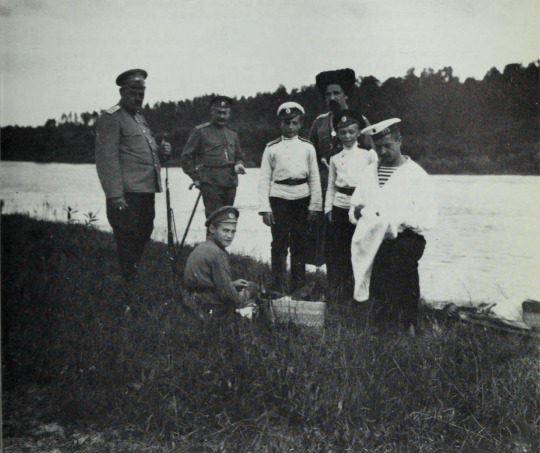

Cadets Evgeni Makarov and Vasili Agaev - Part X (Final in the series)
This is the last post of photographs which feature the Tsesarevich’s good friends, Cadets Evgeni Makarov and Vasili Agaev. These three photographs come from various sources (some of them unknown, as I’ve had these photographs saved for such a long time and have forgotten where some of them are originally from).
Cadets Makarov and Agaev (affectionately referred to as “Zhenya” and “Vasya” by the Tsesarevich, and his family), came to Stavka at Mogilev (General Headquarters) in mid-late Summer of 1916. In the Tsesarevich’s diary entries, his times spent at “HQ” were some of the happiest in his life. He felt the most freedom there as opposed to Tsarskoe Selo where he was surrounded always by “fussy women.”
________________________________________________________________
Photographs:
1. Tsesarevich Alexei Nikolaevich with Cadets Evgeni Makarov (back-ground, center, right) and Vasili Agaev (foreground, in profile, left), as well as, Sailor Klementy Nagorny (in profile, far left) and three other un-identified men.
2. Tsesarevich Alexei Nikolaevich with Cadets Evgeni Makarov (back-ground, right) and Vasili Agaev (back-ground, center), as well as, Sailor Klementy Nagorny (foreground, far right), Petr Petrov (far left), General Voeikov (back-ground, left) and an un-identified cossack (“The Last Tsar,” sourced below).
3. Tsesarevich Alexei Nikolaevich with Cadets Evgeni Makarov (center, with a bottle) and Vasili Agaev (center, left), as well as, Boatswain Andrei Derevenko (far left), Petr Petrov (right of Tsesarevich Alexei Nikolaevich) and Pierre Gilliard (far right).
________________________________________________________________
Sources:
“The Last Tsar.” - Virginia Cowles. Published, Circa. 1977.
Link of courtesy:
https://archive.org/details/lasttsar00cowl/page/219/mode/2up
#evgeni makarov#vasili agaev#simbirsk cadet corps#orlovsky-bakhtin cadet corps#tsesarevich alexei#alexei nikolaevich#romanov#imperial russia#photographs#1916#russian archival material#russian state archives#great war#first world war#tribute post
6 notes
·
View notes
Photo

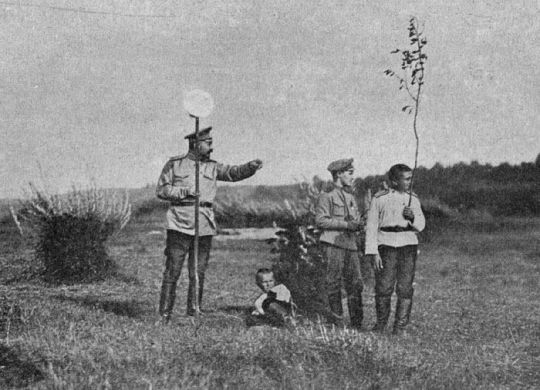
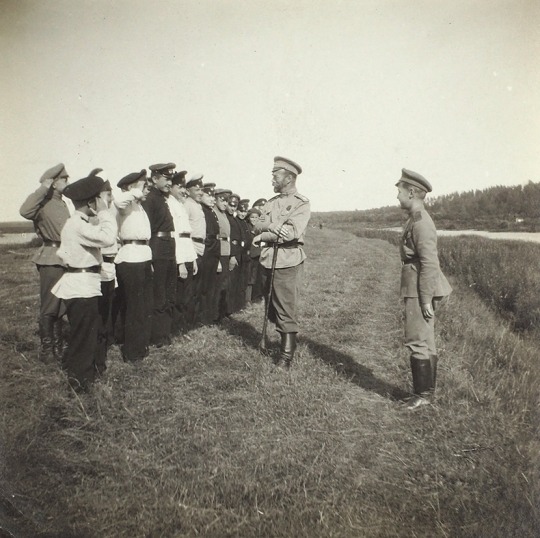
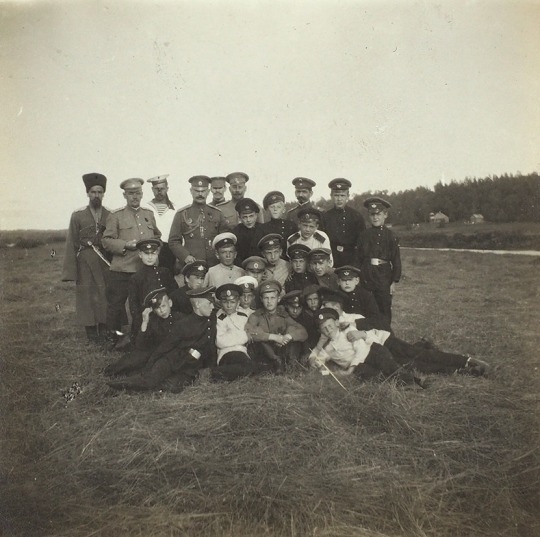

Cadets Evgeni Makarov and Vasili Agaev - Part IX
As promised, here is the continuation of photographs which feature the Tsesarevich’s good friends, Cadets Evgeni Makarov and Vasili Agaev. These five photographs come from various sources (some of them unknown, as I’ve had these photographs saved for such a long time and have forgotten where some of them are originally from).
Cadets Makarov and Agaev (affectionately referred to as “Zhenya” and “Vasya” by the Tsesarevich, and his family), came to Stavka at Mogilev (General Headquarters) in mid-late Summer of 1916. In the Tsesarevich’s diary entries, his times spent at “HQ” were some of the happiest in his life. He felt the most freedom there as opposed to Tsarskoe Selo where he was surrounded always by “fussy women.”
________________________________________________________________
Photographs:
1. Tsesarevich Alexei Nikolaevich with Cadets Evgeni Makarov (right) and Vasili Agaev (left), as well as, Sailor Klementy Nagorny (back-ground, behind Tsesarevich Alexei Nikolaevich and Cadet Vasili Agaev), and Petr Petrov (far right).
2. Tsesarevich Alexei Nikolaevich with Cadets Evgeni Makarov (center, lying down) and Vasili Agaev (right), as well as, General Vladimir Voeikov (far right).
3. Tsesarevich Alexei Nikolaevich with Cadets Evgeni Makarov (foreground, in profile, left) and Vasili Agaev (behind Cadet Evgeni Makarov), as well as, Tsar Nicholas II (center).
4. Tsesarevich Alexei Nikolaevich with Cadets Evgeni Makarov (foreground, center, left) and Vasili Agaev (center, behind Tsesarevich Alexei Nikolaevich and Cadet Evgeni Makarov), as well as, Petr Petrov (back-ground, far left), Sailor Klementy Nagorny (back-ground, far left), General Vladimir Voeikov (back-ground, left) and Pierre Gilliard (back-ground, far right).
5. Tsesarevich Alexei Nikolaevich with Cadets Evgeni Makarov (center) and Vasili Agaev (in profile, far right), along with, Sailor Klementy Nagorny (far right, between Cadets Evgeni Makarov and Vasili Agaev) and General Vladimir Voeikov (back-ground, far left, behind Tsesarevich Alexei Nikolaevich), as well as, three other un-identified men. ________________________________________________________________
Sources:
Международный ВИК "Морской Гвардейский Экипаж"
Romanov News - Новости Романовых (Facebook Community)
Аукционный дом “Литфонд”
Link of courtesy:
http://guardcrew.com/?q=node/255
https://www.facebook.com/PageRomanovNews
https://www.litfund.ru/auction/74/197/
#evgeni makarov#vasili agaev#simbirsk cadet corps#orlovsky-bakhtin cadet corps#tsesarevich alexei#alexei nikolaevich#romanov#imperial russia#photographs#1916#russian archival material#russian state archives#great war#first world war#tribute post
8 notes
·
View notes
Photo
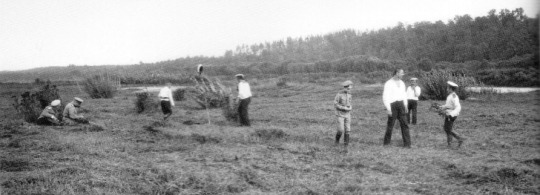


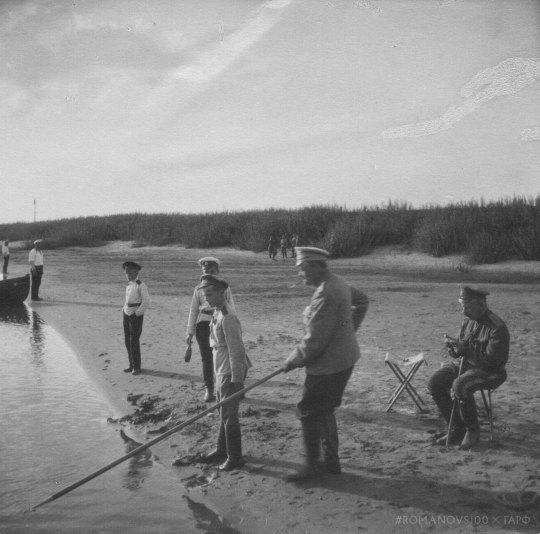

Cadets Evgeni Makarov and Vasili Agaev - Part VIII
As promised, here is the continuation of photographs which feature the Tsesarevich’s good friends, Cadets Evgeni Makarov and Vasili Agaev. These five photographs come from various sources (some of them unknown, as I’ve had these photographs saved for such a long time and have forgotten where some of them are originally from).
Cadets Makarov and Agaev (affectionately referred to as “Zhenya” and “Vasya” by the Tsesarevich, and his family), came to Stavka at Mogilev (General Headquarters) in mid-late Summer of 1916. In the Tsesarevich’s diary entries, his times spent at “HQ” were some of the happiest in his life. He felt the most freedom there as opposed to Tsarskoe Selo where he was surrounded always by “fussy women.”
________________________________________________________________
Photographs:
1. Tsesarevich Alexei Nikolaevich (center, right) with Cadets Evgeni Makarov (back-ground, left with his back turned) and Vasili Agaev (far right, in profile), as well as, Sailor Klementy Nagorny (between Tsesarevich Alexei Nikolaevich and Cadet Vasili Agaev), along with four other un-identified men.
2. Tsesarevich Alexei Nikolaevich with Cadets Evgeni Makarov (far right) and Vasili Agaev (between Tsesarevich Alexei Nikolaevich and Cadet Evgeni Makarov), as well as, Tsar Nicholas II (far left), the Tsesarevich’s pet Spaniel, Joy (behind Tsesarevich Alexei Nikolaevich), and three other un-identified men.
3. Tsesarevich Alexei Nikolaevich with Cadets Evgeni Makarov (back-ground, behind Cadet Vasili Agaev and Tsesarevich Alexei Nikolaevich) and Vasili Agaev (right).
4. Tsesarevich Alexei Nikolaevich with Cadets Evgeni Makarov (far left) and Vasili Agaev (behind Tsesarevich Alexei Nikolaevich), as well as, Petr Petrov (in profile, next to Tsesarevich Alexei Nikolaevich), and General Vladimir Voeikov (sitting, far right).
5. Tsesarevich Alexei Nikolaevich with Cadets Evgeni Makarov (back-ground, center) and Vasili Agaev (far left), as well as, General Vladimir Voeikov (foreground, center). ________________________________________________________________
Sources:
Romanov News - Новости Романовых (Facebook Community)
Romanovs100 (Facebook Community)
Alexander Palace Time Machine - Discussion Forum Board
Link of courtesy:
https://www.facebook.com/PageRomanovNews
https://www.facebook.com/Romanovs100/
https://forum.alexanderpalace.org/index.php/topic,
12844.msg536561/topicseen.html#msg536561
#evgeni makarov#vasili agaev#simbirsk cadet corps#orlovsky-bakhtin cadet corps#tsesarevich alexei#alexei nikolaevich#romanov#imperial russia#photographs#1916#russian archival material#russian state archives#great war#first world war#tribute post
5 notes
·
View notes
Photo
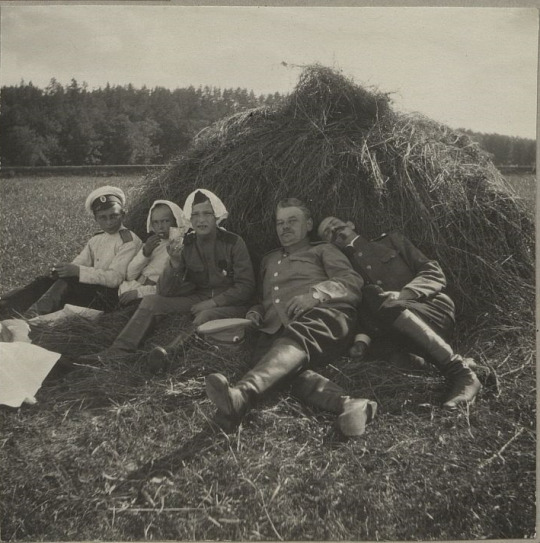

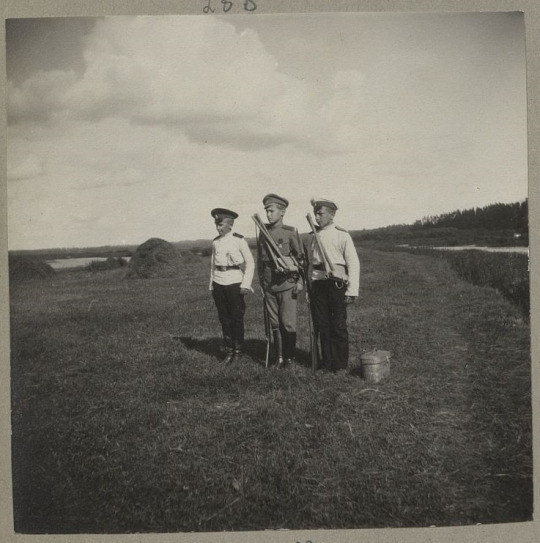

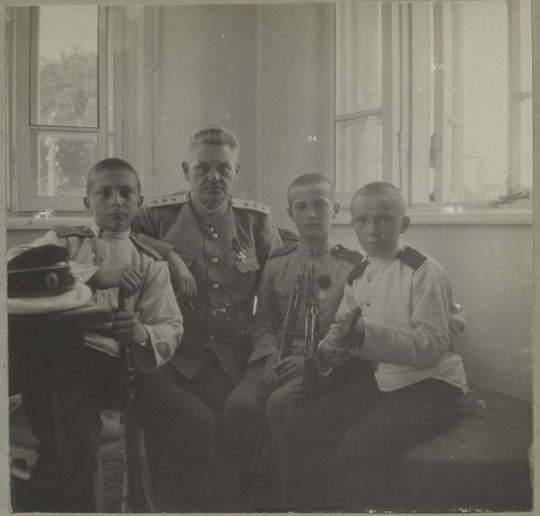
Cadets Evgeni Makarov and Vasili Agaev - Part VII
(Continuation of the 1916-1917 Album of Grand Duchess Anastasia Nikolaevna)
These five photographs come from the Album of Grand Duchess Anastasia Nikolaevna (Circa. 1916-1917). If one peruses through the albums (generously scanned by Ilya Grigoriev), you can see that copies of the same photograph were pasted into various albums belonging to the Grand Duchesses, as well as, Their Majesties.
Cadets Makarov and Agaev (affectionately referred to as “Zhenya” and “Vasya” by the Tsesarevich, and his family), came to Stavka at Mogilev (General Headquarters) in mid-late Summer of 1916. In the Tsesarevich’s diary entries, his times spent at “HQ” were some of the happiest in his life. He felt the most freedom there as opposed to Tsarskoe Selo where he was surrounded always by “fussy women.”
This is the end of photographs of the two boys, in the way of the Imperial Family’s private photograph albums. In other albums and funds (archives) are other photographs. I plan on sharing these too (though they probably have already been posted on here xD) - but I need some shut-eye!
Good night everyone (actually, good morning!), hope you enjoyed this series of posts. ^_^
________________________________________________________________
Photographs:
1. Tsesarevich Alexei Nikolaevich with Cadets Evgeni Makarov (left) and Vasili Agaev (far left), as well as, Petr Petrov (right) and Pierre Gilliard (far right).
2. Tsar Nicholas II (far right) with Cadets Evgeni Makarov (standing, left) and Vasili Agaev (sitting, infront of Cadet Evgeni Makarov), as well as, Tsesarevich Alexei Nikolaevich (center, next to Cadet Vasili Agaev).
3. Tsesarevich Alexei Nikolaevich with Cadets Evgeni Makarov (left) and Vasili Agaev (right).
4. Cadets Evgeni Makarov (right) and Vasili Agaev (left), as well as, Petr Petrov (next to Cadet Vasili Agaev) and Boatswain Andrei Derevenko (next to Cadet Evgeni Makarov).
5. Tsesarevich Alexei Nikolaevich with Cadets Vasili Agaev (left) and Evgeni Makarov (right), as well as, Petr Petrov (center, between Cadet Vasili Agaev and Tsesarevich Alexei Nikolaevich).
________________________________________________________________
Sources:
Альбом Анастасии Николаевны, 1916-1917 гг.
Link of courtesy:
https://www.flickr.com/photos/149552988@N02/albums/72157703990478911
#evgeni makarov#vasili agaev#simbirsk cadet corps#orlovsky-bakhtin cadet corps#tsesarevich alexei#alexei nikolaevich#imperial russia#photographs#1916#1917#russian archival material#ilya grigoriev#russian state archives#great wave#first world war#tribute post#romanov
60 notes
·
View notes